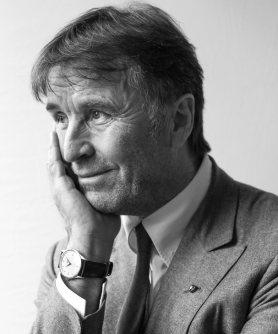Brunello Cucinelli was born in 1953 in Castel Rigone, a small 15th-century village in the province of Perugia, into a family of farmers. After earning a diploma in surveying, he enrolled in the Faculty of Engineering but eventually discontinued his studies. In 1978, he founded a small business and amazed the market with the idea of dyeing cashmere in vibrant colors. Since childhood—witness to the hardships endured by his father in the workplace and a keen observer of the world—he nurtured the dream of work that respects the moral and economic dignity of man.
His deep care for the place where humankind lives led him to consider, protect, and promote everything that could improve the planet and its inhabitants. His greatest teachers were the Ancient Greeks, a people who, more than any other, taught the world about beauty, truth, and measure.
Great Greek philosophers such as Pythagoras, Aristotle, Plato, Epicurus, and Xenophanes, along with poets like Homer and Hesiod, taught Cucinelli the importance of the Earth—“from which everything comes”—and the concept of Genius Loci, that immaterial entity which embodies the soul of the world and speaks to humankind in a silent language, heard by all who love the planet as the home of all living and non-living things, and therefore feel called to be its guardians.
Every architectural project carried out in Solomeo began with a dialogue with the Genius Loci; as much as possible, the land was respected and not exploited through new constructions. In this, his guiding lights were the Renaissance masters who, inspired by the ancients, created human-scale architecture in harmony with the landscape—figures such as Leon Battista Alberti, Palladio, Bramante, and Sebastiano Serlio, each of whom grounded their knowledge in Vitruvius and passed it on through their sublime art to the modern age.
These artists spread knowledge of proportion, measure, and simplicity—generators of beauty—and an awareness of the material and spiritual value of objects that accompany human life, of their durability, and of the value of repair, deeply cherished by John Ruskin. Ruskin believed that the lives of people remain imprinted in the things they create, thus giving those objects a sense of sacredness. This is why the restorations in Solomeo have been carried out by Umbrian artisans who have passed down the crafts of masonry and gardening from father to son.
Every noble element has served to realize projects aimed at human and environmental well-being. Inspired by great philosophers such as Rousseau, Hobbes, Hume, Vico, and Voltaire, Cucinelli envisioned the need for a new social contract with Creation. The first such contract can be seen in The Canticle of the Creatures by Saint Francis of Assisi in the 13th century—a revolutionary act of dialogue with animated and inanimate nature, treating it on equal terms with all other elements of the Earth and heavens.
His vision of work, grounded in respect for human dignity in all its material and immaterial aspects, gave birth to a new and original form of humanistic capitalism and human sustainability—both expressions of his deep reverence for the world.
In 1985, Cucinelli purchased the ruined 14th-century castle in the village and made it the headquarters of his company. In 2000, he acquired and renovated existing manufacturing facilities at the foot of Solomeo, choosing not to build new ones.
The construction of the Forum of the Arts, including a Theater, Amphitheater, Gymnasium, and the Neohumanistic Aurelian Library (he has also served as President of the Teatro Stabile dell’Umbria since 2000), and the soon-to-open Universal Library of Solomeo, established a dedicated space for culture and the arts.
In the outskirts of Solomeo, he restored the Church and rectory of Mandoleto, located in an area once inhabited by the Etruscans—as confirmed by excavations in the 1990s which unearthed walls and artifacts from the 4th century BC. This redevelopment project extends beyond the church to include the surrounding land.
As a philanthropist, he financed the restoration of the Etruscan Arch, the Cathedral of Perugia, and the Teatro Morlacchi. After the earthquake, he contributed to the reconstruction of the Theater and Civic Tower of Norcia, and prepared a long-term plan for rebuilding the village of Castelluccio di Norcia. The plan, developed over three years, aims to imagine a reborn town designed to last more than 500 years.
In 2012, his company was listed on the Milan Stock Exchange, a decision made to broaden participation in his entrepreneurial vision and to spread the ideals of humanistic capitalism and human sustainability.
In 2013, inspired by figures such as William Morris, John Ruskin, and Robert Owen, he founded the School of Solomeo for Arts and Crafts. In 2014, he launched the Project for Beauty, creating three vast parks in the valley below Solomeo (the Agrarian Park, the Lay Oratory Park, and the Industry Park), restoring land once occupied by disused factories to plant trees, orchards, and meadows. The project includes a large vineyard with a winery, an olive grove, and a monument to human dignity.
In 2018, in collaboration with Massimo de Vico Fallani, he wrote The Dream of Solomeo as a manifesto of his humanistic and economic ideals.
Since 2019, he has hosted the Universal Symposium of the Soul and Economy in Solomeo, gathering the greatest minds in global technology.
In 2021, at the invitation of Prime Minister Mario Draghi, he spoke at the G20 on the topics of humanistic capitalism and human sustainability, alongside then Prince Charles, who addressed climate sustainability.
MVF25
MODENA
MVF25
MODENA
MVF25
MODENA
MVF25
MODENA
MVF25
MODENA
MVF25
MODENA
MVF25
MODENA
MVF25
MODENA
MVF25
MODENA
MVF25
MODENA

